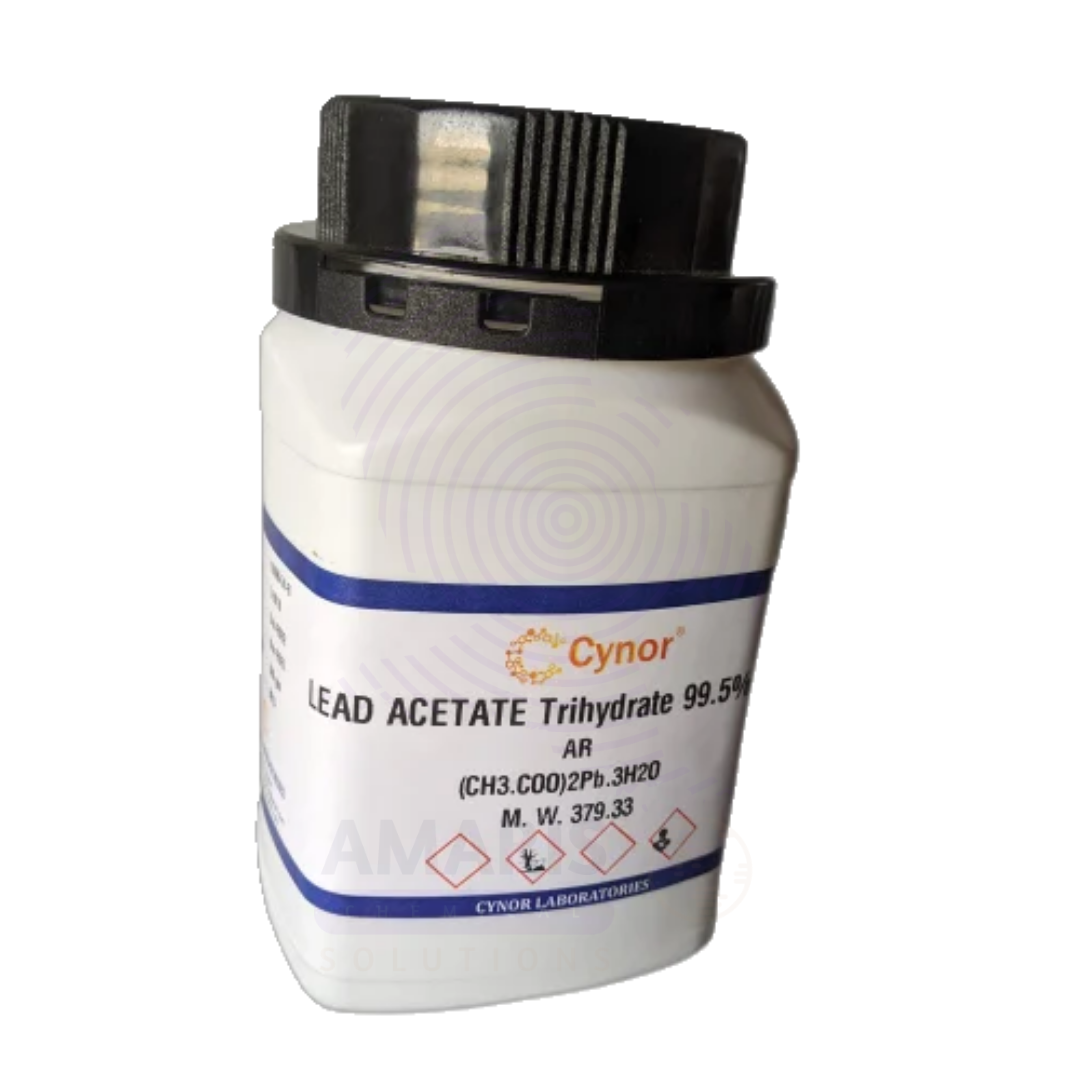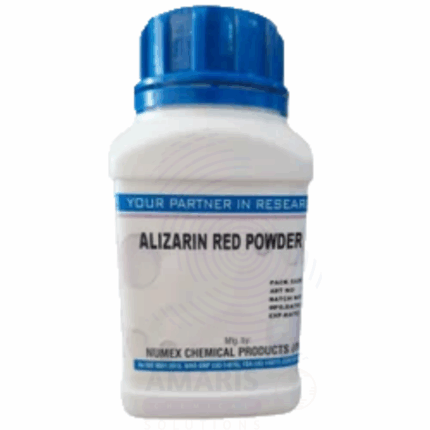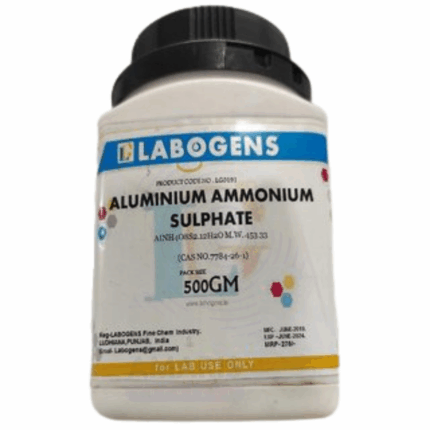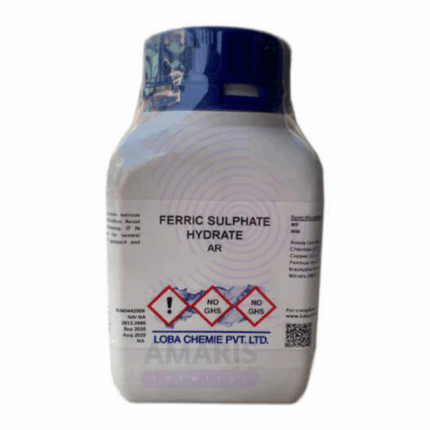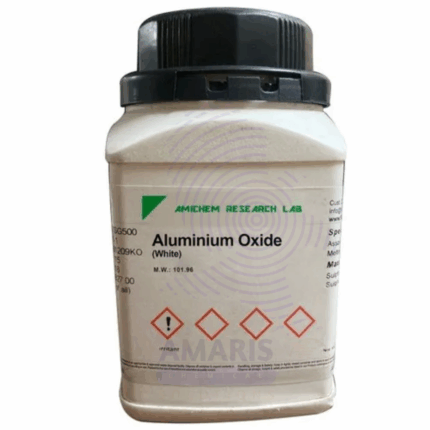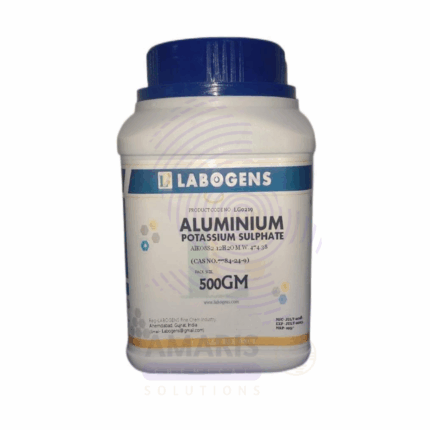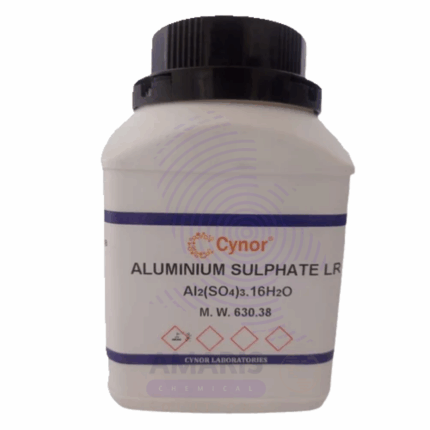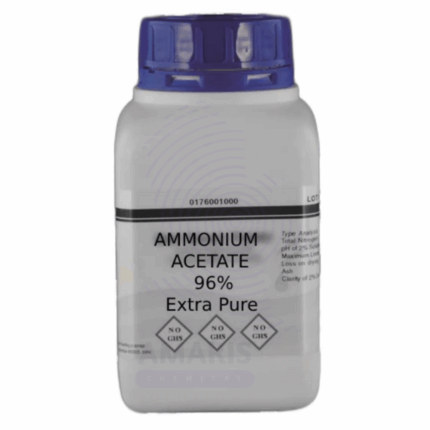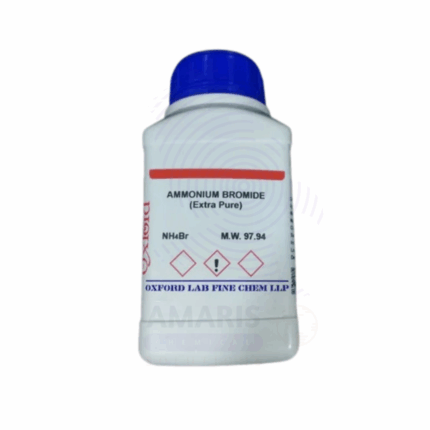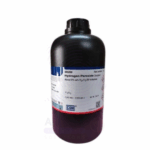

Lead Acetate Extra Pure
$ 17.85 Original price was: $ 17.85.$ 17.76Current price is: $ 17.76.
Lead Acetate Extra Pure is a crystalline compound with the chemical formula Pb(C₂H₃O₂)₂·3H₂O, often referred to as sugar of lead due to its sweet taste (though it is highly toxic). In laboratory environments, it is primarily used for analytical chemistry, precipitation reactions, and as a reagent for detecting hydrogen sulfide gas, with which it forms black lead sulfide. It is also utilized in organic synthesis and historical pigment studies. Due to its toxicity, handling requires strict safety measures, including gloves, goggles, and proper ventilation. Its extra pure grade ensures minimal contaminants, making it suitable for precise experimental procedures.
Lead Acetate Extra Pure
Primary Uses
- Analytical Reagent for Sulfide Detection:
Commonly used to detect hydrogen sulfide (H₂S) gas via the formation of black lead sulfide (PbS) precipitate in qualitative analysis. - Precipitation Reagent:
Utilized to precipitate halides, chromates, and sulfates during classical inorganic analysis. - Synthesis of Other Lead Compounds:
Acts as a starting material for preparing other lead salts and organolead compounds in synthetic and materials chemistry.
Secondary Uses
- Fixative in Histology:
Occasionally used in microscopy preparations for fixing and staining tissue samples, particularly for nuclear detail. - Textile Mordant Research:
Studied for its role as a mordant in dyeing, especially in historical textile and pigment research. - Study of Heavy Metal Toxicity:
Employed in toxicology research to investigate lead bioaccumulation, enzyme inhibition, and neurotoxicity in cell or animal models.
| PACK SIZE |
500 grams Plastic Tin |
|---|
1. Basic Identification Attributes
- Chemical Name: Lead(II) Acetate
- Synonyms: Acetic acid, lead(2+) salt; Sugar of Lead
- Chemical Formula: Pb(C₂H₃O₂)₂·3H₂O (trihydrate form)
- CAS Number: 6080-56-4
- Molecular Weight: 379.33 g/mol (trihydrate)
- Grade: Extra Pure (analytical/laboratory use)
- Appearance: White crystalline solid
- Odor: Slight acetic odor
- Solubility: Soluble in water and glycerol, slightly soluble in ethanol
- Taste: Sweet, but highly toxic — do not ingest
2. Safety & Hazard Attributes
- GHS Classification:
- Acute Toxicity (Oral) – Category 4
- Reproductive Toxicity – Category 1A
- Specific Target Organ Toxicity (Repeated Exposure) – Category 2
- Aquatic Chronic – Category 2
- Hazard Statements:
- H302: Harmful if swallowed
- H360: May damage fertility or the unborn child
- H373: May cause damage to organs through prolonged or repeated exposure
- H411: Toxic to aquatic life with long lasting effects
- Precautionary Statements:
- P201: Obtain special instructions before use
- P264: Wash hands thoroughly after handling
- P273: Avoid release to the environment
- P280: Wear protective gloves, clothing, eye and face protection
- Personal Protective Equipment (PPE):
- Lab coat
- Chemical-resistant gloves (e.g., nitrile)
- Safety goggles or face shield
- Dust respirator (if airborne dust risk)
- First Aid Measures:
- Inhalation: Move to fresh air, seek medical attention
- Skin Contact: Wash with soap and water
- Eye Contact: Rinse with water for 15 minutes, get medical aid
- Ingestion: Do not induce vomiting, seek immediate medical help
- Fire Hazards:
- Not flammable
- Extinguishing Media: Water spray, dry chemical, foam, or CO₂
- Avoid dust buildup—may support combustion of other materials
3. Storage & Handling Attributes
- Storage Conditions:
- Store in tightly sealed containers
- Keep in a cool, dry, well-ventilated area
- Store away from acids, strong oxidizers, and food items
- Label as Toxic and handle in accordance with local regulations
- Handling Tips:
- Use with adequate ventilation or under fume hood
- Avoid dust formation and contamination of work areas
4. Laboratory Applications
- Primary Uses:
- Used in qualitative analysis for detection of sulfides
- Mordant in textile dyeing and printing processes (limited modern use)
- Precipitating agent in chemical synthesis
- Historical use in cosmetics and hair dyes (now restricted)
- Secondary Uses:
- Demonstrations of toxic heavy metal reactions
- Reagent in preparation of other lead compounds
- Teaching aid for illustrating heavy metal chemistry (with strict safety controls)
SAFETY PRECAUTIONS
Personal Protective Equipment (PPE):
- Wear a lab coat, chemical-resistant nitrile gloves, and safety goggles.
- Use a certified respirator if dust or fumes may be generated.
- Work in a fume hood to minimize inhalation risks.
Handling:
- Handle with extreme care; avoid all contact.
- Do not eat, drink, or smoke while handling.
- Prevent dust formation; avoid inhalation, ingestion, or skin/eye contact.
- Wash hands and face thoroughly after handling.
Storage:
- Store in a cool, dry, well-ventilated area away from incompatible materials.
- Keep the container tightly closed and clearly labeled.
- Store separately from acids, oxidizing agents, and food items.
FIRST AID MEASURES
Inhalation:
- Move the person to fresh air immediately.
- Provide oxygen if breathing is difficult.
- Seek urgent medical attention.
Skin Contact:
- Remove contaminated clothing.
- Wash skin thoroughly with soap and water for at least 15 minutes.
- Seek medical advice if irritation or symptoms develop.
Eye Contact:
- Rinse cautiously with water for at least 15 minutes.
- Remove contact lenses if present and easy to do.
- Continue rinsing and get immediate medical attention.
Ingestion:
- Rinse your mouth thoroughly with water.
- Do NOT induce vomiting.
- Seek immediate medical attention—lead compounds are toxic if ingested.
FIRE FIGHTING MEASURES
Flammability:
- Not flammable but may decompose at high temperatures to form toxic fumes.
Extinguishing Media:
- Use water spray, dry chemical, foam, or CO₂ depending on surrounding fire.
Hazardous Combustion Products:
- May emit toxic lead fumes and carbon oxides upon decomposition.
Firefighter Protection:
- Wear full protective clothing and self-contained breathing apparatus (SCBA).
- Avoid inhalation of toxic vapors or dust.


 Preservatives(food)
Preservatives(food) Flavor Enhancers
Flavor Enhancers Acidulants
Acidulants Sweeteners
Sweeteners Antioxidants
Antioxidants Colorants(food)
Colorants(food) Nutraceutical Ingredients (food)
Nutraceutical Ingredients (food) Nutrient Supplements
Nutrient Supplements Emulsifiers
Emulsifiers
 Collectors
Collectors Dust Suppressants
Dust Suppressants Explosives and Blasting Agents
Explosives and Blasting Agents Flocculants and Coagulants
Flocculants and Coagulants Frothers
Frothers Leaching Agents
Leaching Agents pH Modifiers
pH Modifiers Precious Metal Extraction Agents
Precious Metal Extraction Agents
 Antioxidants(plastic)
Antioxidants(plastic) Colorants (Pigments, Dyes)
Colorants (Pigments, Dyes) Fillers and Reinforcements
Fillers and Reinforcements Flame Retardants
Flame Retardants Monomers
Monomers Plasticizers
Plasticizers Polymerization Initiators
Polymerization Initiators Stabilizers (UV, Heat)
Stabilizers (UV, Heat)
 Antifoaming Agents
Antifoaming Agents Chelating Agents
Chelating Agents Coagulants and Flocculants
Coagulants and Flocculants Corrosion Inhibitors
Corrosion Inhibitors Disinfectants and Biocides
Disinfectants and Biocides Oxidizing Agents
Oxidizing Agents pH Adjusters
pH Adjusters Scale Inhibitors( water)
Scale Inhibitors( water)
 Antioxidants(cosmetic)
Antioxidants(cosmetic) Emollients
Emollients Fragrances and Essential Oils
Fragrances and Essential Oils Humectants
Humectants Preservatives
Preservatives Surfactants(cosmetic)
Surfactants(cosmetic) Thickeners
Thickeners UV Filters
UV Filters
 Fertilizers
Fertilizers Soil Conditioners
Soil Conditioners Plant Growth Regulators
Plant Growth Regulators Animal Feed Additives
Animal Feed Additives Biostimulants
Biostimulants Pesticides (Herbicides, Insecticides, Fungicides)
Pesticides (Herbicides, Insecticides, Fungicides)
 Active Pharmaceutical Ingredients (APIs)
Active Pharmaceutical Ingredients (APIs) Excipients
Excipients Solvents(pharmaceutical)
Solvents(pharmaceutical) Antibiotics
Antibiotics Antiseptics and Disinfectants
Antiseptics and Disinfectants Vaccine Adjuvants
Vaccine Adjuvants Nutraceutical Ingredients (pharmaceutical)
Nutraceutical Ingredients (pharmaceutical) Analgesics & Antipyretics
Analgesics & Antipyretics
 Analytical Reagents
Analytical Reagents Solvents(lab)
Solvents(lab) Chromatography Chemicals
Chromatography Chemicals Spectroscopy Reagents
Spectroscopy Reagents microbiology-and-cell-culture-reagents
microbiology-and-cell-culture-reagents Molecular Biology Reagents
Molecular Biology Reagents Biochemical Reagents
Biochemical Reagents Inorganic and Organic Standards
Inorganic and Organic Standards Laboratory Safety Chemicals
Laboratory Safety Chemicals Specialty Laboratory Chemicals(Special Laboratory Equipment)
Specialty Laboratory Chemicals(Special Laboratory Equipment)
 Demulsifiers
Demulsifiers Hydraulic Fracturing Fluids
Hydraulic Fracturing Fluids Scale Inhibitors(oil)
Scale Inhibitors(oil) Surfactants(oil)
Surfactants(oil) Drilling Fluids
Drilling Fluids
 Dyes and Pigments
Dyes and Pigments Bleaching Agents
Bleaching Agents Softening Agents
Softening Agents Finishing Agents
Finishing Agents Antistatic Agents
Antistatic Agents
 Admixtures
Admixtures Waterproofing Agents
Waterproofing Agents Sealants and Adhesives
Sealants and Adhesives Curing Compounds
Curing Compounds Concrete Repair Chemicals
Concrete Repair Chemicals Anti-Corrosion Coatings
Anti-Corrosion Coatings
 Surfactants(cleaning)
Surfactants(cleaning) Builders
Builders Enzymes
Enzymes Solvents (Cleaning)
Solvents (Cleaning) Fragrances
Fragrances
 Electronic Chemicals
Electronic Chemicals Catalysts
Catalysts Lubricants
Lubricants Photographic Chemicals
Photographic Chemicals Refrigerants
Refrigerants Automotive chemicals
Automotive chemicals Pyrotechnic Chemicals
Pyrotechnic Chemicals
 Biodegradable Surfactants
Biodegradable Surfactants Bio-based Solvents
Bio-based Solvents Renewable Polymers
Renewable Polymers Carbon Capture Chemicals
Carbon Capture Chemicals Wastewater Treatment Chemicals
Wastewater Treatment Chemicals
 Pigments
Pigments Solvents(paint)
Solvents(paint) Specialty Coatings
Specialty Coatings Binders/Resins
Binders/Resins Additives
Additives Driers
Driers Anti-Corrosion Agents
Anti-Corrosion Agents Functional Coatings
Functional Coatings Application-Specific Coatings
Application-Specific Coatings
 Fresh Herbs
Fresh Herbs Ground Spices
Ground Spices Whole Spices
Whole Spices Spice Blends
Spice Blends Dried Herbs
Dried Herbs
 Leavening Agents
Leavening Agents Dough Conditioners
Dough Conditioners Flour Treatments
Flour Treatments Fat Replacers
Fat Replacers Decoratives
Decoratives Preservatives(baking)
Preservatives(baking)
 Plasticizers & Softeners
Plasticizers & Softeners Reinforcing Agents
Reinforcing Agents Adhesion Promoters
Adhesion Promoters Vulcanizing Agents
Vulcanizing Agents Antidegradants
Antidegradants Blowing Agents
Blowing Agents Fillers & Extenders
Fillers & Extenders Accelerators & Retarders
Accelerators & Retarders